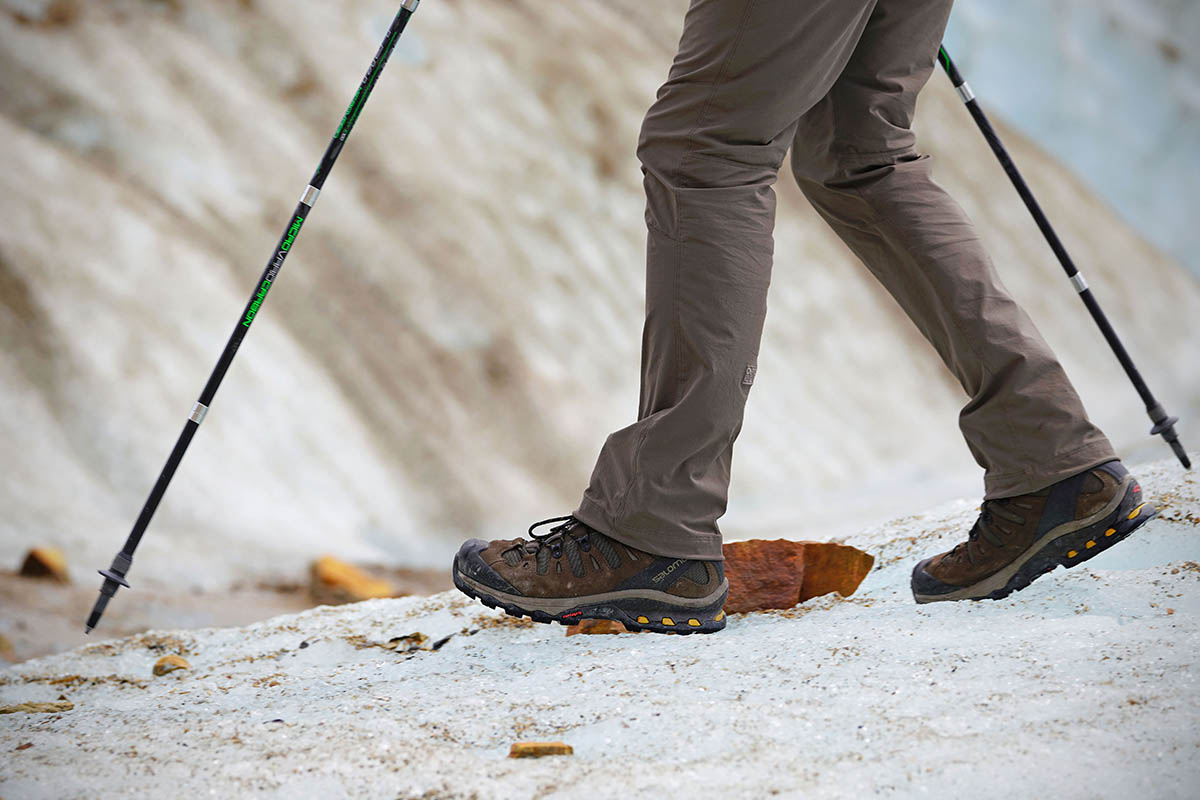
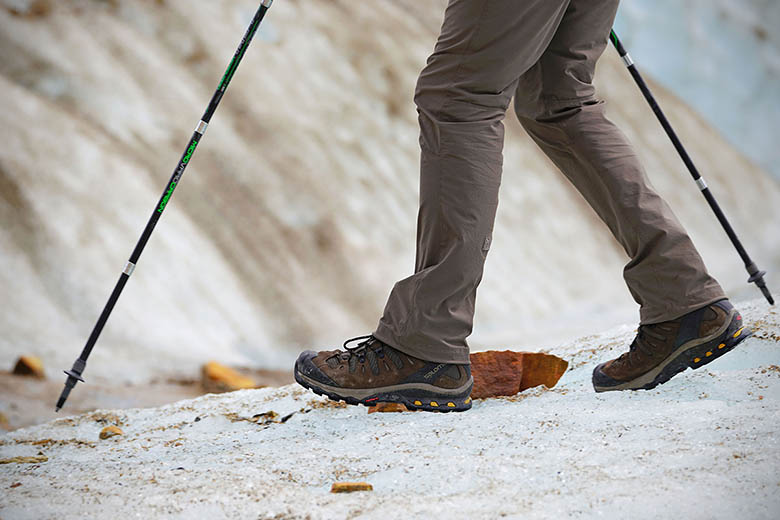
Switchback Travel


Switchback Travel
Price: $230
Weight: 2 lbs. 13.8 oz. (men’s size 9)
Waterproof: Yes
What we like: Excellent support and comfort for navigating tricky terrain with a full pack.
What we don’t: Too stiff and heavy for easy trails.
See the Men's Salomon Quest 4D 3 See the Women's Salomon Quest 4D 3
Salomon’s Quest 4D boot has headlined their backpacking lineup for years, and it remains a solid all-around performer in today’s market. We put the boot to the test while backpacking the rugged Huemul Circuit in Patagonia and found it to be the perfect tool for the job. The Quest is solidly made, provides fantastic support and protection for challenging trails, and retains the aggressive stance and nimble feel of previous generations. Below we break down our experiences with the Quest 4D 3 GTX. To see how it stacks up to the competition, see our article on the best hiking boots.
When putting on the Salomon Quest 4D 3 GTX, it’s immediately apparent that this is a serious boot. The high collar and solid lacing system hold your foot and ankle snugly in place, but generous padding around the ankle and along the boot’s tongue make it very comfortable. It’s stiff enough that I wouldn’t recommend taking it for a long trek straight out the box, but with only a few short hikes under my belt before starting the Huemul Circuit, it had loosened up enough to be fitting like a glove.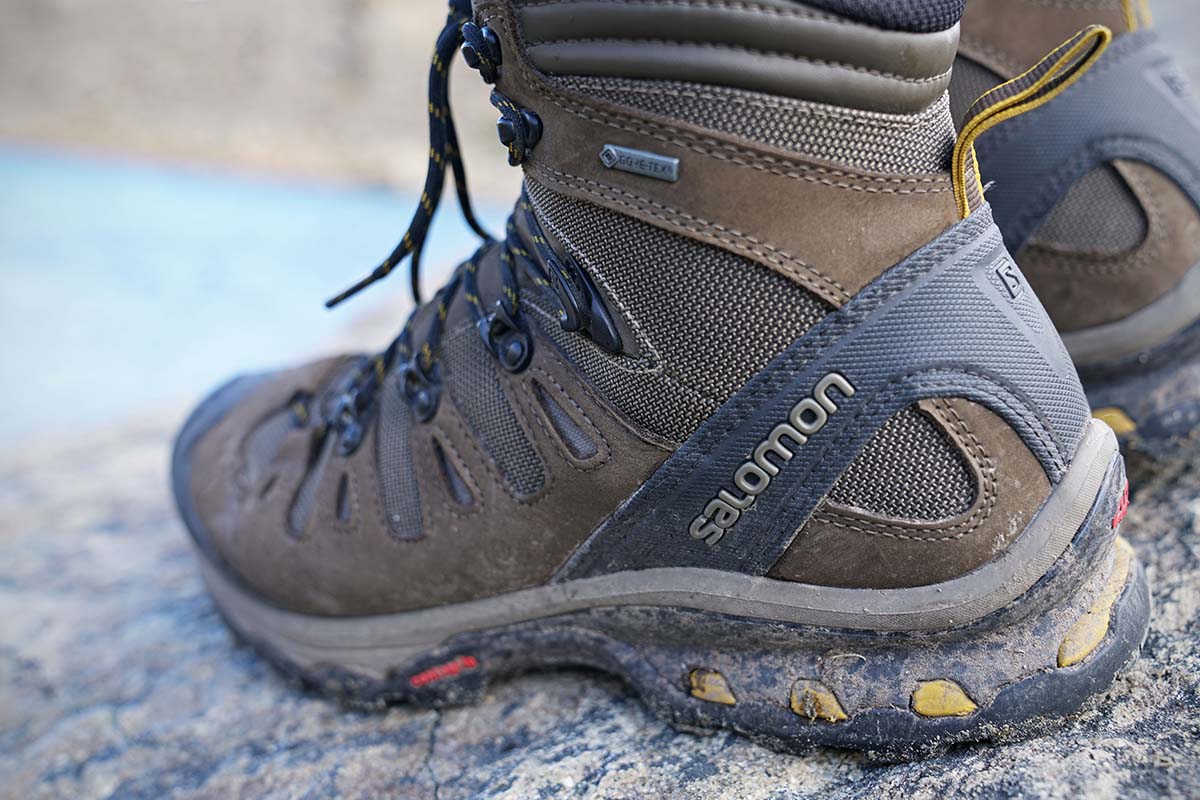
One of my few complaints with the old Quest 4D 2 was that the moderately thin construction underfoot would leave me with sore feet after long days on rocky trails when carrying a heavy pack. But after a strenuous four-day trek in the 4D 3 in precisely that situation, I’m confident in saying the newer hiking boot does a better job isolating your feet from the ground. It’s difficult to pinpoint the source of the improvement—the forefoot is a little more flexible than the old boot taking some of the sting out of each step, and the outsole’s rubber compound also has more “give”—but Salomon seems to have turned this old nitpick into a non-issue.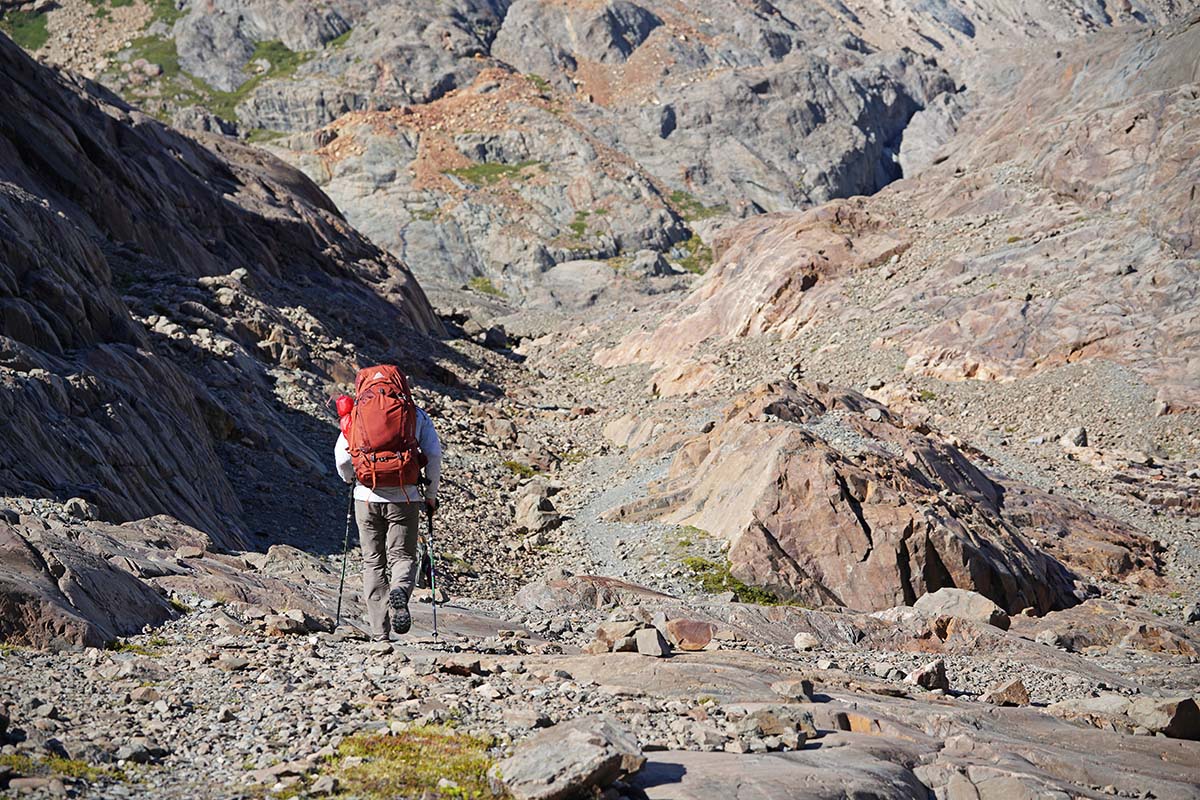
At 2 pounds 13.8 ounces for a pair of men’s size 9s (just 0.6 ounces heavier than its listed weight), the Salomon Quest 4D 3 is almost exactly the same weight as the previous model (this bucks the trend in hiking footwear of always going lighter). And even within the sturdy backpacking-ready category, the Quest falls a little on the heavy side. For instance, competitors like the Lowa Renegade GTX Mid (2 lbs. 7 oz.) and Scarpa Zodiac Plus GTX (2 lbs. 6.4 oz.) both considerably undercut the Salomon. But I think the weight is well-spent with a tall ankle height, burly protection, and class-leading support and comfort. If you’re in the market for a lighter and more flexible boot, we recommend the Salomon X Ultra 3 Mid GTX (1 lb. 15.7 oz.). But for demanding trails and those who want the support, the Quest is worth the additional ounces.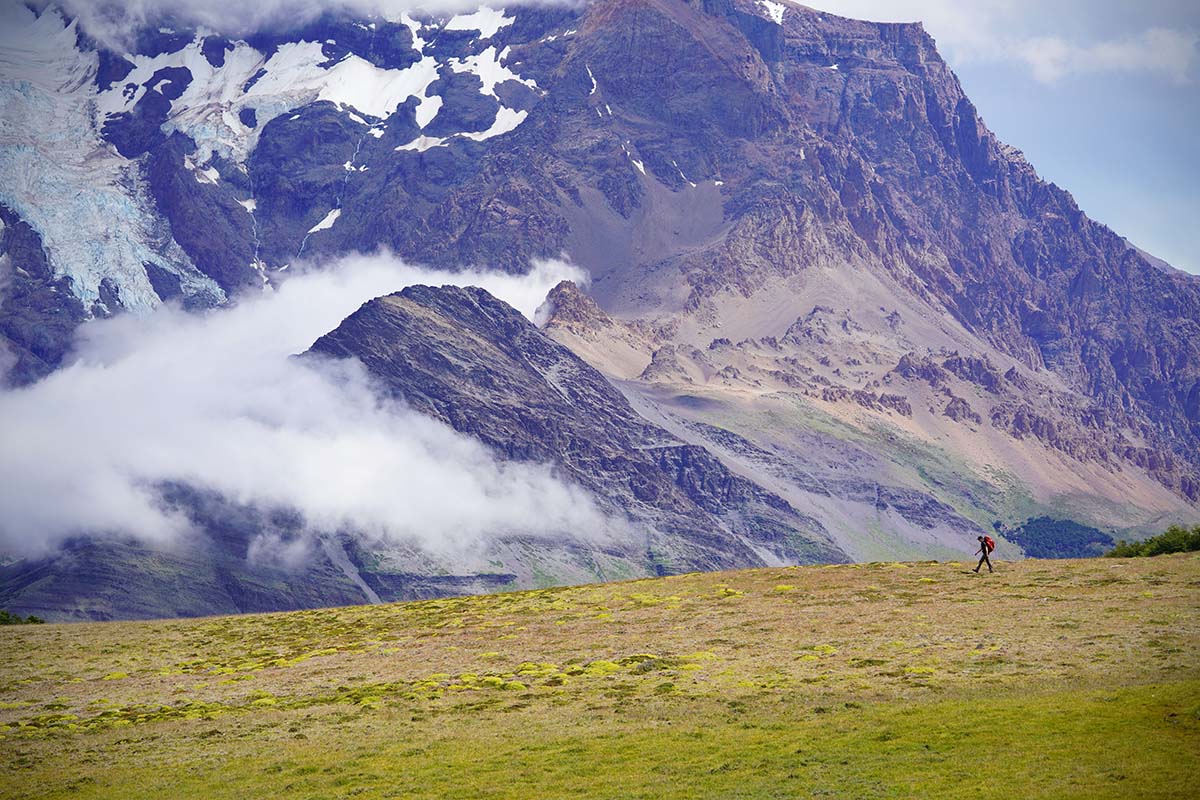
Visually, the Salomon Quest 4D 3 and its predecessor are very similar when upright, but flip them over and you see that Salomon completely redesigned the outsole. The old wave-like look and stiff rubber compound has been replaced with better spacing to avoid caking up in mud, along with a softer Contagrip rubber. Having worn the older Quest 4D 2s extensively over the last few years, I didn’t have major complaints with the traction, but the 3s do seem to have a little more bite on steep sections, and especially on wet surfaces (likely due to the more pliable rubber). The Huemul Circuit is about as demanding and varied as it gets, and I can’t remember one misstep across rock-covered glaciers, up steep passes with hairy and loose descents, and numerous creek crossings (at least the ones shallow enough to keep my boots on). And importantly with this tread design, the lugs have not shown any signs of excessive wear.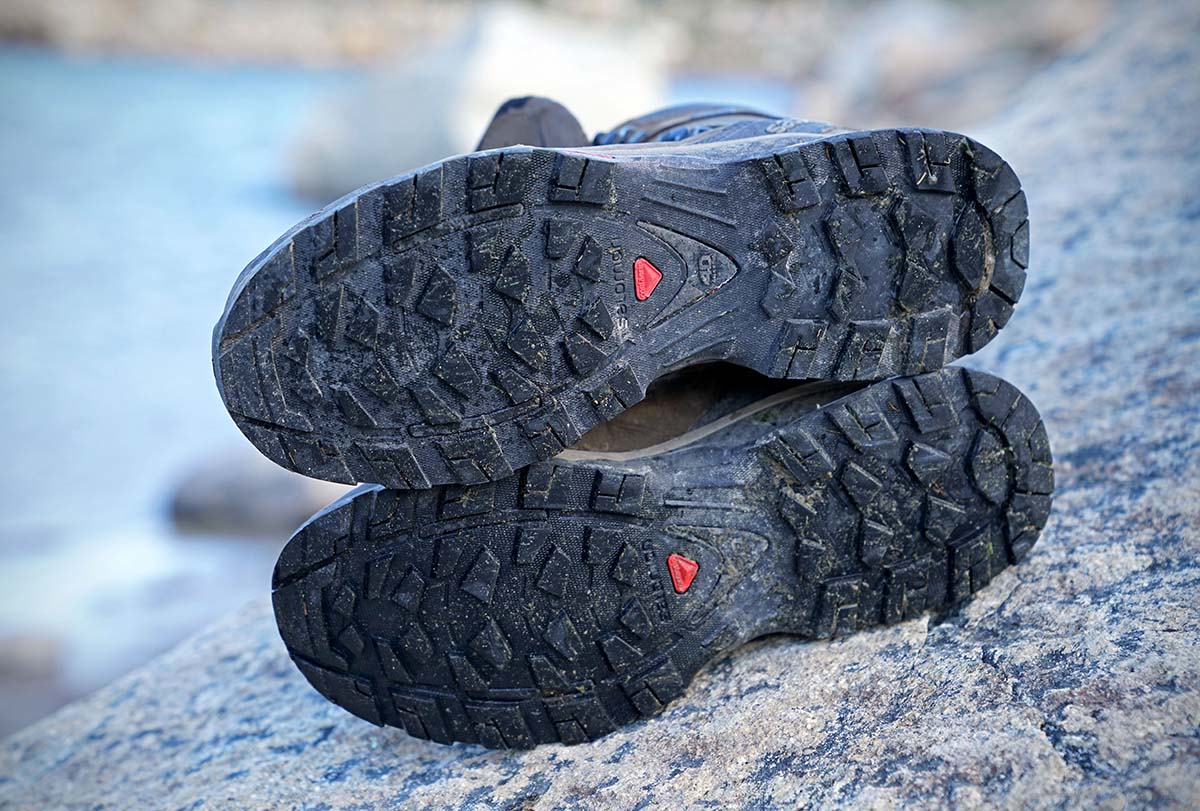
One of the main reasons to upgrade to the Quest over a lightweight hiking boot or shoe is its stable feel. The collar sits higher over the ankle than a standard mid-height boot like the Merrell Moab 2 or Keen Targhee III, but it’s the solid support that sets it apart. The semi-stiff structure does a great job holding your feet in place without feeling restrictive like a mountaineering boot, and time and again I was impressed with how easy it was to trust my footing when carrying a heavy load on loose, rocky ground. In short, the Quest may be overkill on a casual, short-mileage weekend trip, but it was the ideal pairing for the technical terrain we were hiking in Patagonia.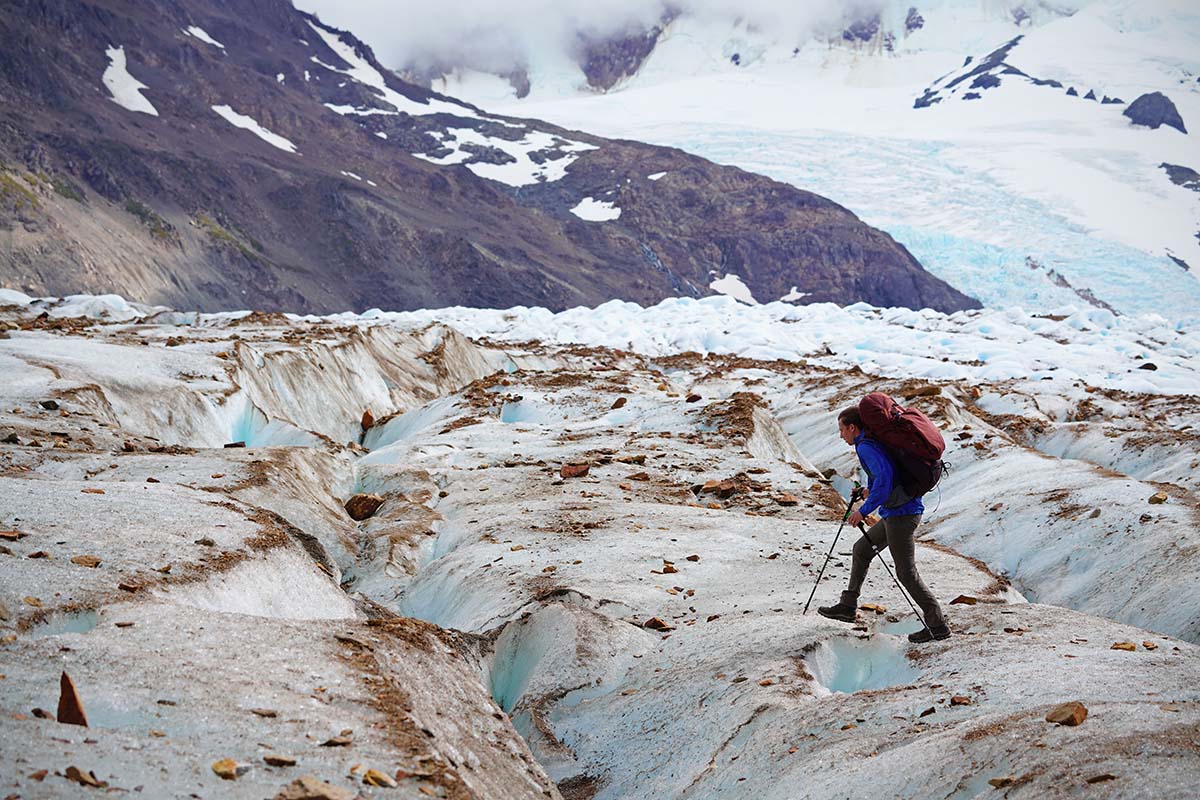
The excellent lacing system, which has been a signature feature of the Quest line dating back to the original, plays a big role in its performance on rough trails. I especially appreciated the set of hooks at the bend in the ankle, which allowed me to lock in my heels on long climbs. Interestingly, Salomon did away with the two sets of locking hooks at the top of the boot (the openings are now a little wider so the laces don’t pop into place), but I haven’t experienced any issues with the laces slipping or loosening throughout very long days of hiking.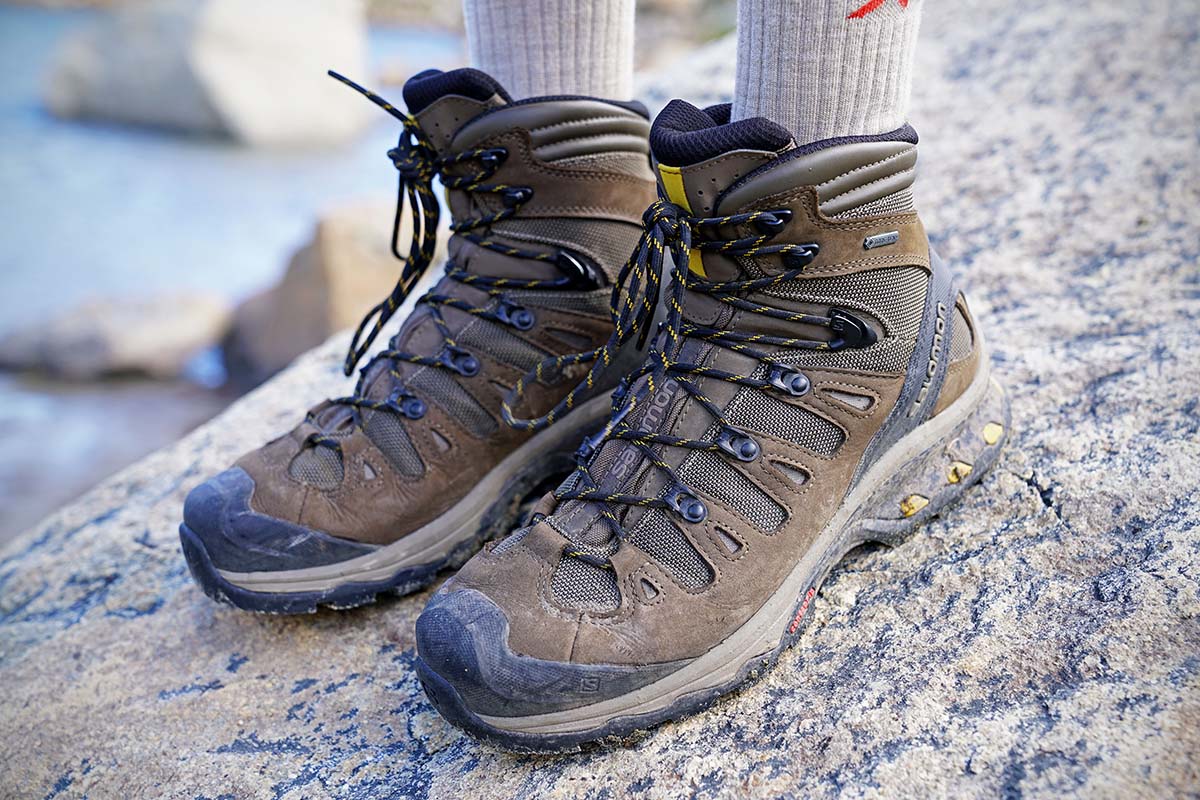
I started my test of the Salomon Quest 4D 3 in the middle of winter in the Pacific Northwest, so I gave the Gore-Tex membrane a thorough workout right off the bat. The subsequent trip to Patagonia involved intermittent rain and more creek (and sometimes river) crossings than I could count, so I have a good grasp on the quality of the design. Outside of a fairly significant misstep when crossing a marshy section off trail, which allowed water over the top of the boot, my feet remained completely dry.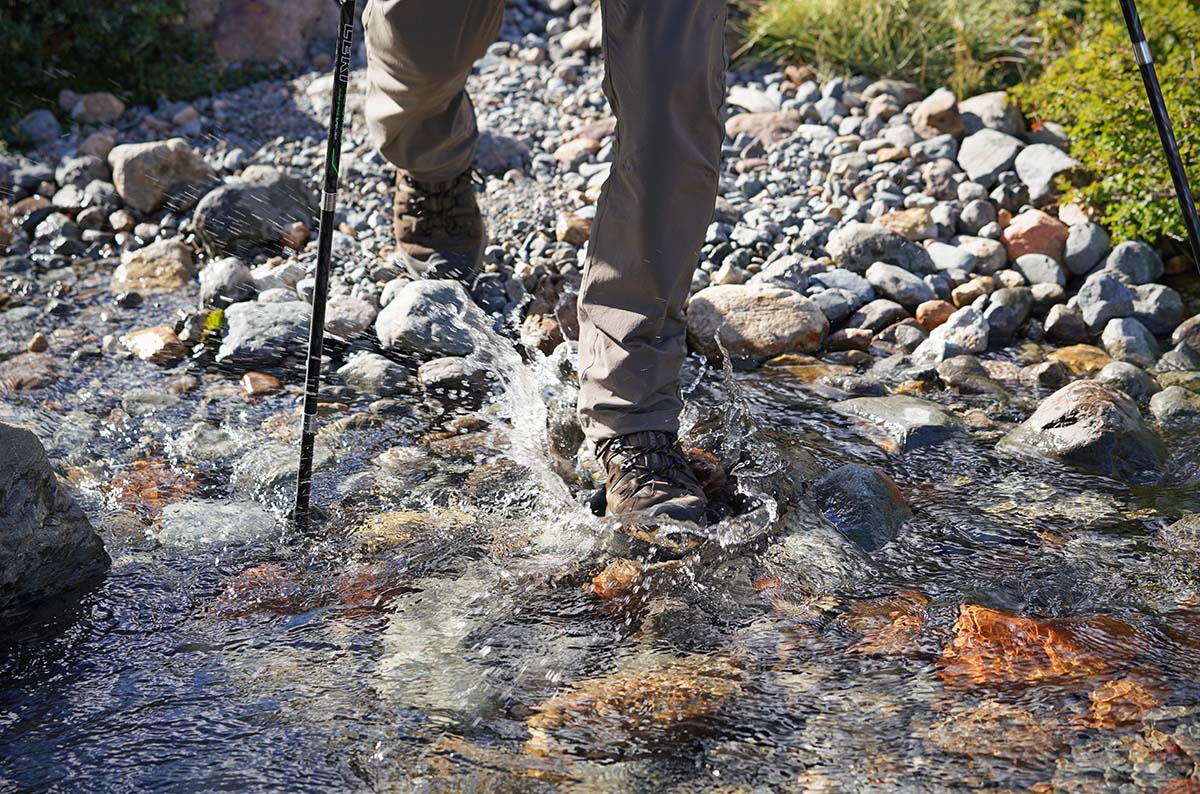
I haven’t had the boots in hot weather yet—our Austral Summer backpacking trip was pretty mild overall—but I haven’t had any issues with breathability. From my experience backpacking in Utah with the old Quest 4D 2 and summer trips with a large number of Gore-Tex boots, I’m not expecting any miracles in the heat. Even a premium membrane won’t keep you totally cool, but with a pair of quality hiking socks and the Quest’s quick-drying upper material (my boots dried completely overnight after the marsh experience), I’d expect them to be a decent ventilator for a waterproof design. And in winter, the membrane has provided a nice boost in warmth, which has kept me comfortable while snowshoeing and hiking down into the mid 20s Fahrenheit.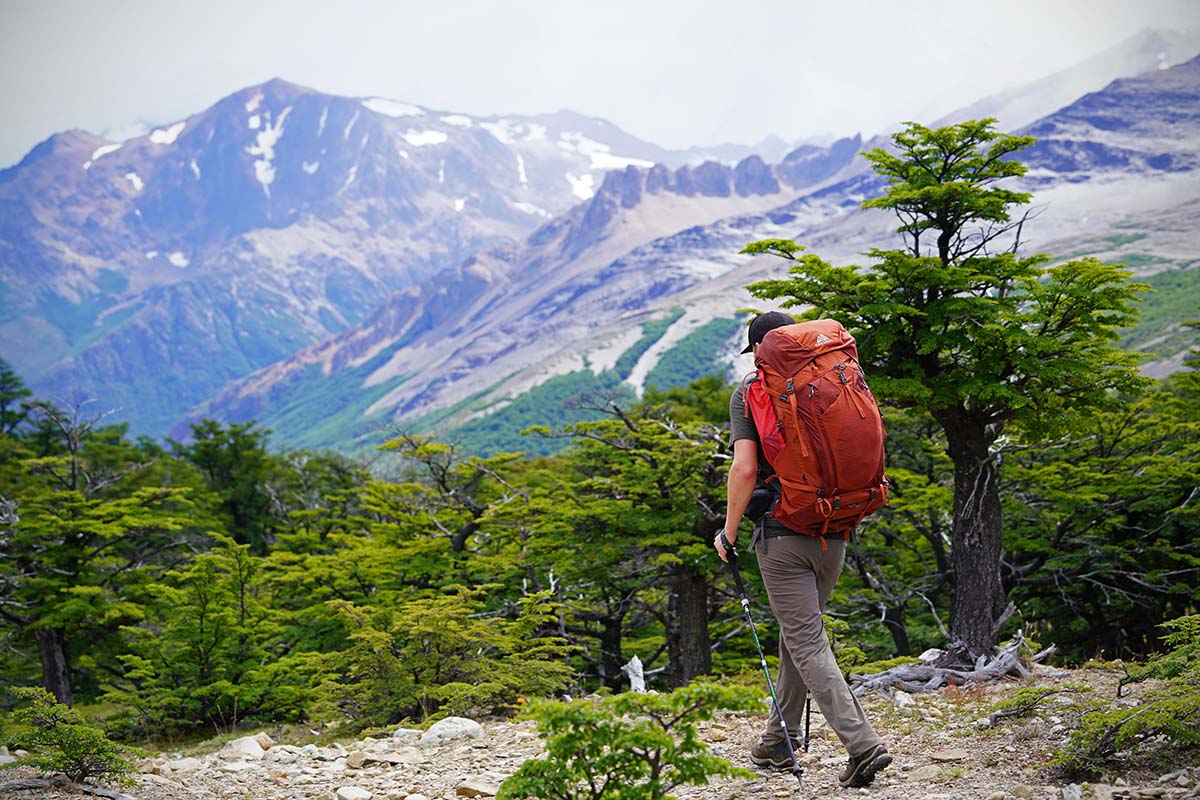
With a tall ankle height and burly toe and heel rubber, the Quest isn’t lacking in foot protection. The boot sits about an inch above my ankle, and with plenty of padding all around, I felt confident even over technical sections on the trail. Compared to the previous version, Salomon did trim down the rubber toe cap along the sides just a little, but it still covers all of my toes and I’ve had no painful impacts. Unless you need approach shoe levels of protection and grip for scrambling and climbing rocks, the Quest provides plenty of security for off-trail and technical use.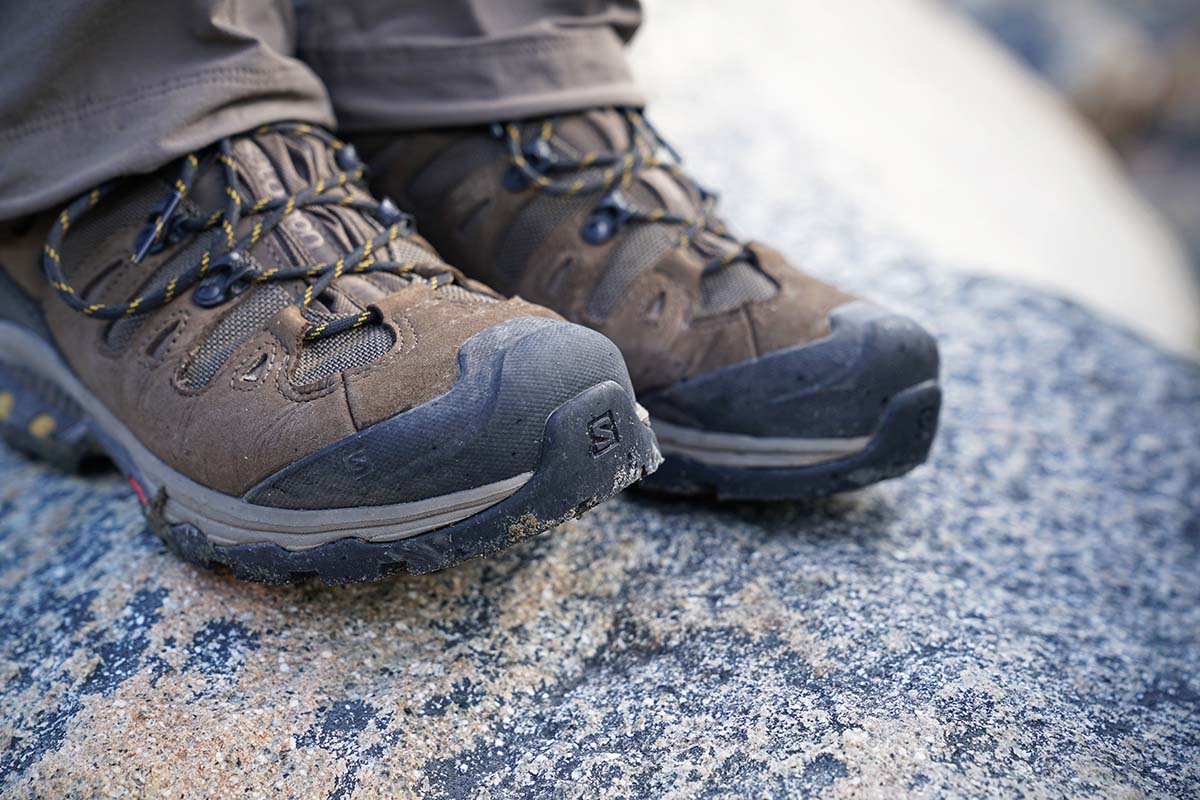
The boot’s rugged look and feel has been backed up with solid durability thus far. There is plenty of evidence of bumps and scrapes from hitting rocks and branches, but the toe cap and leather/textile upper aren’t worse for wear. The same goes for the lacing system: a few eyelets have had the paint scraped off from contact with trail debris, but they’re still solidly in place and the laces are like new. On the underside, the sole has a few lugs that show evidence of the unforgiving terrain, but they’re small and there are no chunks of rubber missing or signs of premature breakdown.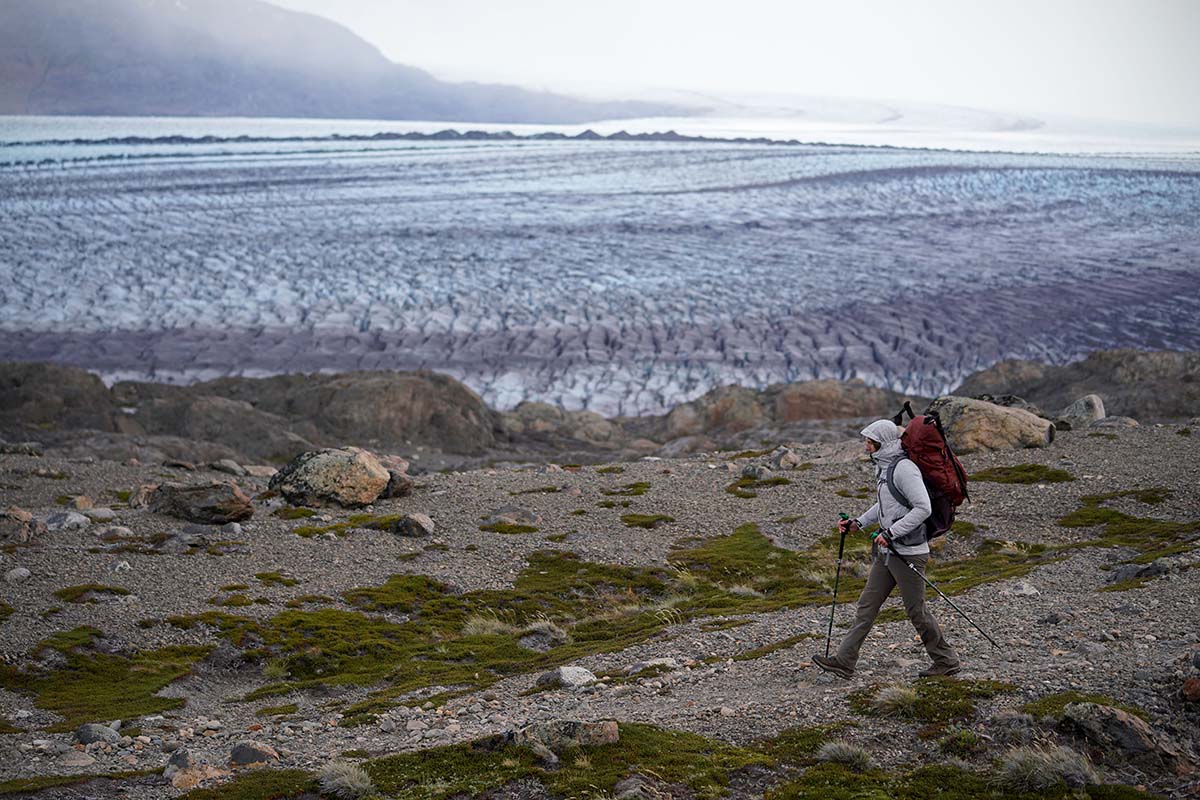
If you’ve worn the previous version of the Quests, there are no surprises with the 4D 3 (they even have the same removable Ortholite insoles). I ordered my typical men’s 9 and it fit very true to size. The length was excellent with enough room to avoid jamming my toes on the relentlessly long descents on the trek, and the snug heel and secure lacing system kept my feet solidly in place. The toe box has an average width (wider than Salomon’s lightweight X Ultra 3), which gives your feet enough space to swell up throughout the day, but it’s not too wide to impact stability. Unfortunately for those with hard-to-fit feet, Salomon does not offer narrow or wide sizes of the Quest like Lowa does with their Renegade GTX Mids..jpg)
We put the men’s Quest through its paces on Patagonia’s Huemul Circuit, and Salomon makes the shoe in a women’s version for the same price. The women’s Quest 4D 3 GTX is around half a pound lighter at 2 pounds 5 ounces and sold in different colorways, but otherwise it retains the same Gore-Tex waterproofing, upper and midsole construction, and Contagrip rubber outsole as its men’s counterpart. Salomon also makes the Quest Prime GTX, which is a trimmed-down and lighter-weight version of the 4D 3 (2 lbs. 8 oz. for the men’s version), and the 4D Forces 2, which is a tactical variation that uses reinforced (read: more durable) materials. Unlike some hiking boots, however, the Salomon Quest 4D 3 isn’t available in non-waterproof, low-top, wide, or narrow versions.
As a follow-up to the model tested here, Salomon recently released the Quest 4 GTX, which costs the same at $230 but features a couple key differences. Namely, Salomon lightly updated the look of the shoe to be more modern and streamlined and added a new chassis that’s designed to boost stability and support. The latest 4 is a bit lighter than the 4D 3 (my men's 9 weighs 2 lbs. 11.2 oz.), but the designs are very similar overall. For more, see our in-depth Salomon Quest 4 review.
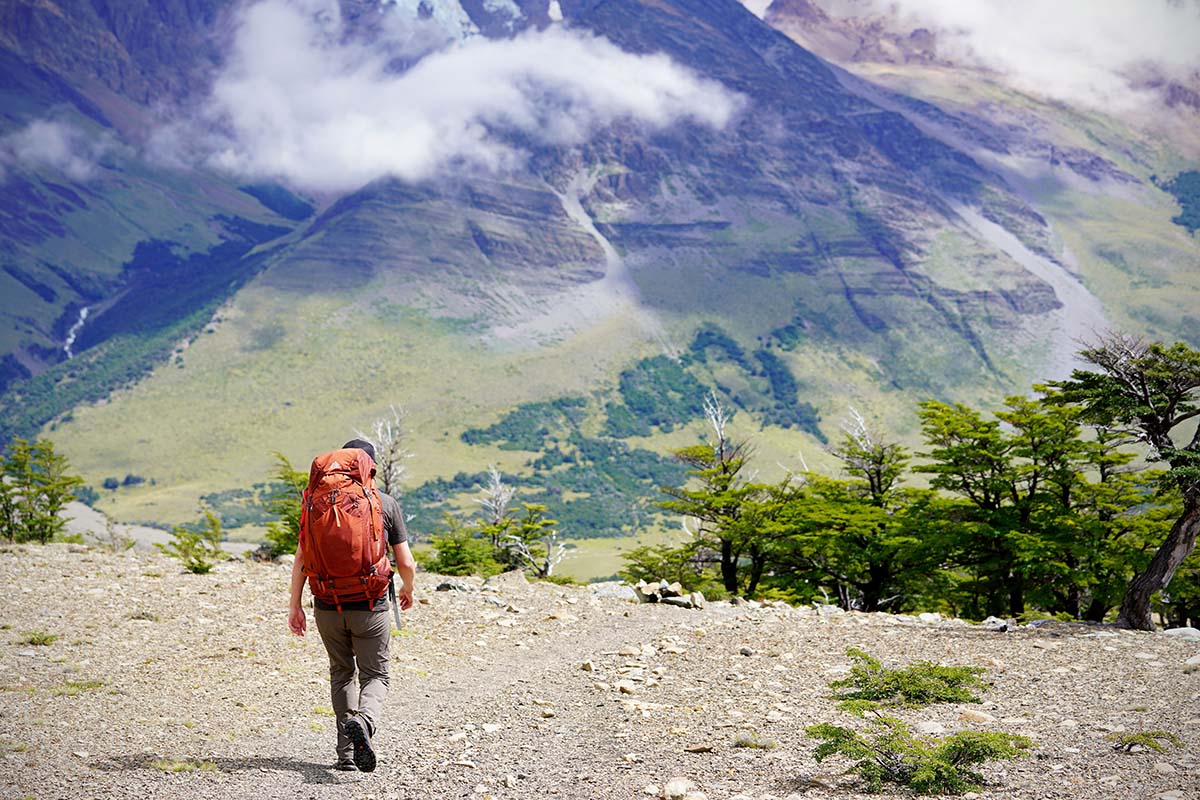
| Boot | Price | Category | Weight | Waterproof | Upper |
|---|---|---|---|---|---|
| Salomon Quest 4D 3 GTX | $230 | Midweight | 2 lb. 13.2 oz. | Yes (Gore-Tex) | Nubuck leather / mesh |
| Lowa Renegade GTX Mid | $240 | Midweight | 2 lb. 7 oz. | Yes (Gore-Tex) | Nubuck leather |
| Scarpa Zodiac Plus GTX | $269 | Midweight | 2 lb. 6.4 oz. | Yes (Gore-Tex) | Suede leather |
| Salewa MTN Trainer Mid GTX | $250 | Midweight | 2 lb. 15.2 oz. | Yes (Gore-Tex) | Suede leather |
| Salomon X Ultra 3 Mid GTX | $165 | Lightweight | 1 lb. 15.7 oz. | Yes (Gore-Tex) | Suede leather / nylon |
| Vasque Breeze AT Mid GTX | $190 | Midweight | 2 lb. 11 oz. | Yes (Gore-Tex) | Nubuck leather / mesh |
The Quest has been towards the top of our hiking boot round-up for years, but it’s certainly not alone in the very competitive midweight market. One of its long-time rivals is the Lowa Renegade GTX Mid. These two boots are proven options for challenging day hikes and long backpacking trips, but the Lowa gets the edge in weight by about 6 ounces for the pair and is offered in a very wide range of sizes and widths. But if the Salomon’s fit you, we think the Quest is the better option: its lacing system is more secure, we love the aggressive running shoe-like stance, and its tougher build offers more protection and durability.
There is a growing selection of lightweight technical boots on the market in 2021, and one of our current favorites is the Scarpa Zodiac Plus GTX. This boot looks and performs a lot like a trimmed-down mountaineering design: it’s stiff, grips well, and provides excellent support and security for rough use. Compared with the Quest, it’s lighter by about 7 ounces but has a little less all-around prowess due to its rigid feel. If you’ll be off trail a lot or need something for light mountaineering, both are solid options, but the Scarpa is more specialized and thus a little less appealing than the Quest for most backpackers.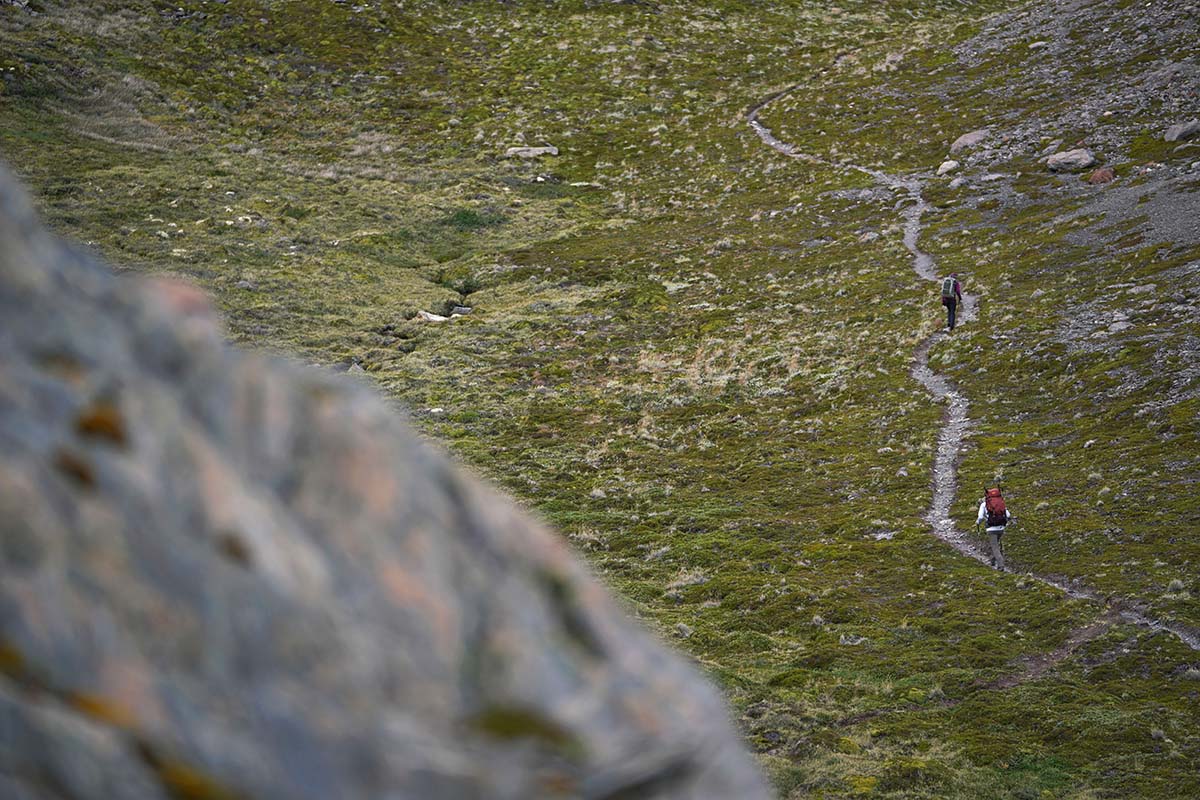
Another supportive and stable alternative to consider is Salewa’s Mountain Trainer Mid GTX, which is designed for rough alpine terrain and harsh mountain conditions. The Salewa is the heaviest design here at 2 pounds 15.2 ounces, but the extra heft does come with a couple notable upgrades. First and foremost, you get a protective, wraparound rand for standout protection from rocks and other trail obstacles, and the approach shoe-like lacing system makes it easy to get a snug fit. The tradeoff is that the Mountain Trainer feels overly stiff and bulky on well-maintained trails, although we had similar complaints with the Quest. But the real clincher for some may be price: at $250, the Mountain Trainer is $20 spendier than the Salomon despite offering less versatility.
Within Salomon’s lineup, a lightweight alternative to the Quest is the X Ultra 3 Mid GTX. At 1 pound 15.7 ounces, this boot is one of our top picks for fast-and-light travel. It provides sufficient support and protection for on-trail use, but its flexible and very nimble feel makes it easy to put on serious mileage. The X Ultra 3 Mid, however, is more limited on serious backpacking trips like the rugged Huemul Circuit. The Quest’s sturdier build, taller ankle height, more secure lacing system, and added protection underfoot are all valuable additions for steep and rough trails. We are big fans of the X Ultra line overall and love the lower weight of the Mid, but it can't match the ruggedness of the Quest 4D 3.
Last but not least is Vasque’s Breeze AT Mid GTX. We tested this boot while hiking in Patagonia and found it offers similar levels of comfort and support as the Quest while coming in $40 cheaper (for more, see our in-depth Breeze AT review). That said, from a performance standpoint, the Quest is the clear winner: its upgraded lacing system and athletic stance deliver a more precise and nimbler feel on the trail. Moreover, the Salomon grips better across a range of surfaces and has a higher-quality, longer-lasting build, which justifies its increased cost for hikers that get out a lot.